
Original Link: https://www.anandtech.com/show/349
The rate of change in the computer industry is amazing, it's an awesome force that makes the market turn, the developers think, and the consumers drool. Just a year ago the market was preparing for the long awaited year end holiday shopping season, Intel and AMD essentially halted any production of newer CPUs until after the holidays as to make the most off their already powerful flagship products. At this point last year Intel was marveling over the power and performance of their Pentium II which had just recently reached speeds of 450MHz with AMD in the background quietly cracking away at the soon to come, Sharptooth (K6-3) processor.
1997 was clearly Intel's year, AMD's competition to the Pentium II was weak and Intel held on to a great percentage of the market share. In 1998 things started to heat up for the boys in blue as AMD started heavy production of the K6-2 and kept up the competition even after Intel went "Celeron-happy7quot; towards the middle of 1998. As much as some people hate AMD, and as much as others hate Intel, the two companies are good for each other. No one is forcing you to buy an AMD processor if you don't want one, and no one is forcing you to buy an Intel processor if you don't want one either. The benefit of the competition can be noticed in the stronger drive to push prices even lower and raise the performance bar even higher.
Originally Intel had not intended to release a 600MHz processor until later in the year, however with information about AMD's forthcoming Athlon causing a stir amongst the boys in blue the roadmap has been accelerated considerably. For the first time in over three years Intel is engaged in a clock for clock battle with their only real competitor in the desktop x86 market, so when AnandTech was given the opportunity to take an in-depth look at Intel's Pentium III 600 we eagerly jumped at the opportunity. What must AMD live up to when the Athlon (K7) finally goes on sale in August? Let's find out...
A Quick Overview
| For those of you that are unfamiliar with the Pentium III architecture, the Pentium III 600 is identical in almost every way to its predecessors, the 550, 500, and 450MHz Pentium III processors. | |
| It is based on the same 0.25 micron OGLA core as the Pentium III 550, 500 and 450 with the only real difference being its rated operating frequency, 600MHz. Operating at a 100MHz FSB frequency and a clock locked 6.0x clock multiplier, the Pentium III 600 is essentially a higher yield Pentium III 550 with a 6.0x clock multiplier. And like all Pentium III processors, the Pentium III 600 features the same SSE (Streaming SIMD Extensions) instructions that separate the Pentium III from the Pentium II. | |
The Pentium III, like the Pentium II, features 32KB of L1 cache that operates at its core clock speed (in the case of the P3-600, that speed is 600MHz) and an additional 512KB of L2 cache that operates at 1/2 its core clock speed (300MHz for the P3-600). As briefly mentioned before, the Pentium III features a clock locked 6.0x clock multiplier, for you overclockers that means that like all Intel processors manufactured after the release of the first Celeron in 1998 the Pentium III 600 can only recognize a single clock multiplier, 6.0x. Contrary to rumors, mystical beliefs, or whatever you'd like to call them, the Pentium II, Pentium III, and Celeron all use the same technology that make them what we like to call "clock locked" (meaning their clock multiplier cannot be manipulated), that technology, without physically modifying (and potentially damaging) the processor cannot be worked around.
The clock multiplier has always been a function of the CPU, never a function of the motherboard. The only reason one would believe that the clock multiplier was a function of the motherboard would be because before clock locking techniques were implemented processors could essentially use whatever multipliers the motherboard's jumper settings instructed them to use as long as they were physically supported by the CPU. Take the original Pentium 200 for example, it operated at a 66MHz FSB frequency and recognized clock multipliers ranging from 1.5x to 3.0x in 0.5x increments. Clocking a Pentium 200 at 66 x 2.0 would result in a 133MHz clock speed, and such a setting was controlled via the motherboard. The idea of having the processor accept a single clock multiplier regardless of what the motherboard told it to use never crossed the minds of the engineers at Intel. With the rise of remarking (i.e. selling a Pentium II 233 overclocked to 266MHz as a Pentium II 266 without telling the customer) as a very common practice among unscrupulous CPU vendors it was time for a change, which was first introduced with the Celeron 266, the first desktop Intel processor to feature a locked multiplier, specifically, 4.0x.
The 6.0x clock multiplier of the Pentium III 600 does not mean that it cannot accept a FSB frequency greater than the 100MHz specification Intel intended it to be used with. So overclockers are still able to push the Pentium III 600 to levels above 600MHz without worrying about the clock lock. The FSB frequency setting is a function of the motherboard, specifically the clock generator on the board, so the available FSB settings (albeit unofficially supported) will vary from motherboard to motherboard.
What Makes the 600 a 600
The retail heatsink/fan the processor ships with make contact with only the chip itself, and leave the L2 cache chips essentially "uncooled" during normal operation, possibly to deter overclocking and remarking by making sure that the L2 cache works fine at its rated frequency/temperature with as little room for tolerance as possible. It is possible to purchase an OEM Pentium III 600 chip that doesn’t ship with the retail heatsink/fan and use a third party cooling solution that does take care of cooling the L2 cache chips if you’re that worried.
The Pentium III 600 still operates at the same 2.0v core voltage setting that all processors since the Pentium II 333 have been running at, and generally requires the use of an active cooler (heatsink/fan combo) for proper operation. The only requirements for compatibility are that the motherboard supports the Pentium III processor, and the 100MHz FSB. With the exception of Intel’s own motherboards, the Pentium III 600 worked fine on all BX motherboards AnandTech tested it on. Most older motherboards without a BIOS update detected the processor as a MMX 26MHz processor but after flashing the BIOS with the latest updates the BIOS reported the correctly identified Pentium III running at 600MHz. As with the Pentium III 550, with the 600, you’ll most likely need an updated BIOS before you can plug a 600 in.
The Pentium III 600 should work fine in any BX board with an updated BIOS as all BX boards have support for the processor’s 2.0v core voltage specification. The only problem that may arise is with cheaper BX boards manufactured without the intent of supporting the amount of current the Pentium III 600 draws in mind. Most boards should have no problem supplying the current necessary for the Pentium III 600 to operate within spec however one can’t make the generalization about all BX boards, as there are a remote few out there that do boast sub par quality levels.
The main factor that separates the Pentium III 600 from the 550, or even the 500 or 450 parts is the topic of yield, both of the processor itself and the L2 cache. Intel’s manufacturing process has undoubtedly advanced considerably since the days of the original Pentium, we first truly realized this with the wonderful Celeron 300As that would overclock a full 150MHz to 450MHz frequencies. Intel is constantly improving their manufacturing process and with time, it will get even better, thus making the first differentiating factor between the 600 and previous Pentium III processors, the quality of the yield. From our tests on the first samples of the Pentium III 600 it can be concluded that there is very little, if any, noticeable difference in the quality of the processor yield between the Pentium III 550 and the 600. As the life of the 600 extends this will change, however for now, the Pentium III 600 is essentially a Pentium III 550 with a higher clock multiplier.
The L2 cache of the Pentium III 600 on the other hand is a little more different than that of the Pentium III 550. While both processors generally feature L2 cache that in real world situations can make it beyond 300MHz operating frequencies, the Pentium III 600’s L2 cache is guaranteed at 300MHz. This gives the Pentium III 600 a little more tolerance for overclocking although most Pentium III 550 owners that are happily running at 616MHz will argue with the value of such a guarantee.
The Processor Identification Number: Danger or Paranoia?
As mentioned in AnandTech’s original Pentium III review and the Pentium III 550 review, the Pentium III is the first processor to boast Intel’s new processor identification number technology that basically gives your processor an individual identification number which is unique to your processor alone. This number can allow your processor to be tracked down via the Internet for a variety of purposes, and at the same time the number has obviously caused a lot of commotion in the industry.
Motherboard manufacturers have quickly jumped on the bandwagon of supporting the ability to disable the number via their BIOS setup utility, so if the number’s presence is that bothersome to you then you should write your motherboard manufacturer if an update to your BIOS hasn’t already been made. At the same time, programmers are saying that there are methods to enable the number even if it is off already. This poses a problem as many believe that the ability for your presence to be tracked on-line is a severe violation of your privacy. Whether the threat of Intel’s new id system is a dangerous threat or just paranoia on the part of the users, the conclusion of the argument is this: the number is included on Pentium III processors, including the newly release 600MHz parts.
In reality, your final decision shouldn’t be swayed by whether or not your processor features a traceable serial number however it can be an influential force in forming your opinion of manufacturers that do boast the technology. In some cases the identification number is actually a security advantage as the data stored on the processor now allows you to run a utility supplied by Intel that will report the proper FSB and clock multiplier settings the CPU was made to run at. What must be pointed out is that there wasn’t a dire need for such a drastic move by Intel proving that in some cases, necessity isn’t the mother of invention.
The Future of the Pentium III
"The physical limit of the Pentium III’s current manufacturing process happens to be around the 700MHz mark, meaning that it wouldn’t be too far fetched to "hypothesize" the 0.18 micron Coppermine processors that are due out later this year would feature clock speeds of around 700MHz+. It also wouldn’t be surprising to see the "mysterious" arrival of a 600MHz Pentium III (not Coppermine, current technology – 0.25 micron) if AMD does indeed ship their upcoming K7 at 550MHz as planned. Intel won’t stand idle as AMD takes the lead in the clock frequency race, and the potential of the overclocked 550 is proof in itself that Intel could make the move to 600MHz and beyond if the need were to come around."
That statement was made in AnandTech’s Pentium III 550 review completed less than six months ago, low and behold, the "mysterious" arrival of a 600MHz Pentium III (0.25 micron) is upon us. With the Pentium III 550, it was confirmed that a 700MHz clock speed could in fact be attained on the current manufacturing process. Intel’s 0.18 micron Coppermine processor (the next generation Pentium III) is experiencing delay after delay and the release of AMD’s Athlon (K7) at speeds greater than 600MHz is very likely within the next two months. It wouldn’t be surprising if Intel extended the life of the current manufacturing process once again, the Pentium III 600 may see a 650MHz brother if the Pentium III 667 (133MHz FSB) doesn’t make its way out the door soon enough. It was almost guaranteed that we’d see a 600MHz Pentium III after the release of the 550MHz part, since AMD was already leaking information about 600MHz Athlon parts available for sale the day of the official release.
From experiences dealing with Intel directly, the company generally knows what the competition is preparing. Intel knew more about the Athlon than the general public and even some reviewers, a somewhat interesting fact but impressive nonetheless. Intel should have some idea of what AMD is preparing in terms of 650MHz parts, if not, let’s just put it this way, Intel isn’t the only company that has accelerated their roadmap. AMD is looking to go head to head with Intel, bar none and if that means releasing a 700MHz Athlon before year’s end, then it may come to that.
There is no doubt about it, Intel accelerated the release of the Pentium III 600 to within days of the physical release of the Athlon 600 processor for the sake of competition. What’s AMD’s response? A six, a five, and a zero. Although they may not know it, the ball is in Intel’s court now, don’t you just love competition?
Overclocking
As we have come to expect and take for granted (most tweakers feel cheated if their Intel CPUs won't overclock), Intel's high yield on their 0.25 micron parts has given us the ability to overclock to a healthy degree in order to gain a helpful bit of performance free of charge. It was once thought that 550MHz would be the theoretical limit of Intel's 0.25 micron manufacturing process, however the delays in Intel's Camino (820) chipset and the move to a 0.18 micron fabrication process as well as increasing heat from AMD to push the 600MHz limit has forced Intel to release the 600MHz part based on their 0.25 micron core. AnandTech's Pentium III 600 sample was able to make it up to 660MHz by using the 112MHz FSB frequency, anything above 660MHz was either too unstable (even with an increase in the core voltage) for normal operation or would not boot at all.
For the fastest desktop Intel processor available today, the overclocking outlook of the Pentium III 600 is not that great. With a bit of added cooling it may be able to hit the 700MHz mark as we were able to get the system to cold boot at 700MHz however the test bed would hang after a very short period of time, often times not making it past the Power On Self Test. As Intel's yields improve on the Pentium III 600, reaching the 700MHz mark will become more dependent on the quality of the L2 cache and the ability of it to run at 1/2 of 700MHz, or 350MHz.
For those of you that are interested in the performance gains provided by overclocking, take a look at the following chart that illustrates the gain in Business Application Performance:
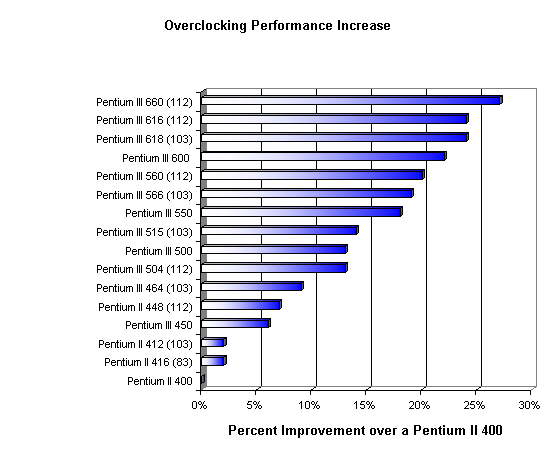
Although the increase in gaming performance will yield different performance results, using the gaming tests we conducted you should be able to generally predict the performance increase you'll receive from overclocking.
The Test
AnandTech's Slot-1 Test Bed was configured as follows:
- ABIT BX6 Revision 2.0 w/ Intel Pentium III 600 Engineering Sample
- 128MB Mushkin SDRAM
- Western Digital Caviar AC35100 - UltraATA
- NVIDIA TNT2 Ultra clocked at 150/183MHz (32MB SDRAM) using Detonator 2.08 drivers
- 3dfx Voodoo3 3000 using Voodoo3 driver kit v1.02.11
Ziff Davis Winstone 99 was run
under Windows 98 SE and Windows NT Workstation 4.0 at 1024 x 768 x 16-bit color
idSoftware's Quake 3 Arena Test 2 v1.07 was run at all four video configuration settings
using q3testdemo1.dm3
Of course the obligatory Winstone 99 test under Windows 98 reveals that the Pentium III 600 (and the 660MHz overclocked counterpart) sit comfortably at the top of the performers...will that change with the release of the Athlon 600? Only time will tell. This is the last time we will use the current test bed configuration here at AnandTech, the Athlon review will be the debut of our newest CPU test bed configuration which should comfortably accompany all future CPU reviews on AnandTech.

Using Microsoft's Netshow Encoder you can see that there's very little difference between the Pentium III 600 and a 550 overclocked to 560MHz. Unfortunately, the Pentium III 600 at 660MHz would not complete the Netshow Encoder benchmarks thus explaining the missing 660MHz benchmarks.
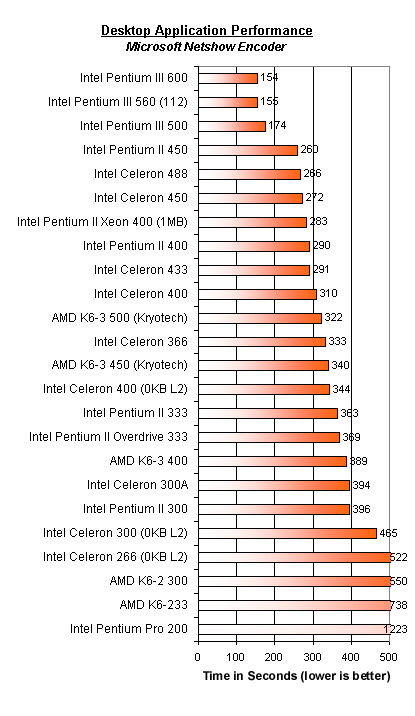
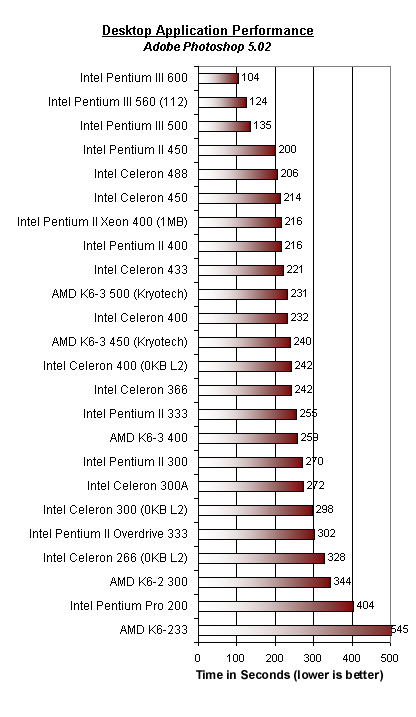
Quake 3 Arena Test 2 (1.07) is the dream benchmark for games, although idSoftware has indicated that the test is in no way representative of the final performance of Q3A upon shipping the test does allow us to run four different levels of benchmarks that stress both processors and video cards alike. The four different settings are taken directly from the system configuration options and are 'Fastest', 'Fast', 'Normal' and 'High Quality'
The benchmark was run by bringing up the console (hit the '~' key), then by typing in 'timedemo 1' and hitting return then typing in 'demo q3testdemo1.dm3' and hitting return. The tests were repeated until consistent results were obtained and then averaged and recorded.
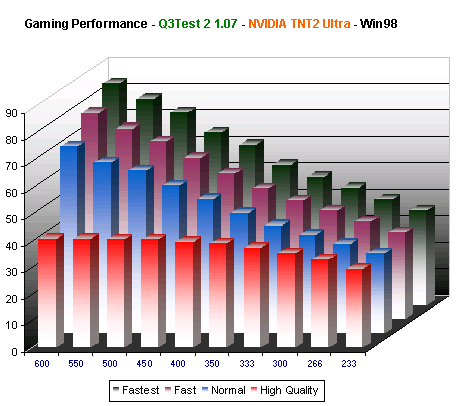
| Gaming Performance - Q3Test 2 1.07 - NVIDIA TNT2 Ultra - Win98 | ||||
Fastest |
Fast |
Normal |
High Quality |
|
Intel Pentium II 233 |
35.6 |
32.9 |
30.1 |
29.6 |
Intel Pentium II 266 |
39.9 |
36.7 |
33.7 |
33.1 |
Intel Pentium II 300 |
44.2 |
41 |
37.3 |
35.4 |
Intel Pentium II 333 |
48.3 |
44.8 |
40.8 |
37.5 |
Intel Pentium II 350 |
52.7 |
49.4 |
45.3 |
39.3 |
Intel Pentium II 400 |
60.4 |
54.9 |
50.8 |
40 |
Intel Pentium III 450 |
65.3 |
60.8 |
55.9 |
40.8 |
Intel Pentium III 500 |
72.7 |
67.2 |
61.3 |
40.9 |
Intel Pentium III 550 |
77.8 |
71.9 |
64.4 |
41 |
Intel Pentium III 600 |
83.8 |
77.7 |
70.6 |
41 |
As you can see, the High Quality setting maxes out the video card's performance, giving the Pentium III 600 very little opportunity to show its increase in power over even the Pentium III 450. The scores taken at the Fastest, Fast, and Normal settings are more representative of increases in gaming performance the Pentium III 600 will provide for you. The absence of the Intel Celeron as well as processors other than the Pentium II/III from this comparison will be made up for in an upcoming CPU comparison on AnandTech, the purpose of this comparison is to simply show the performance increase the Pentium III 600 offers over previous generation P3 and P2 processors.
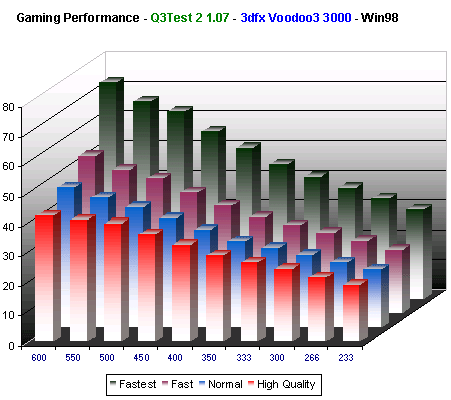
Switching video cards to the Voodoo3 yields a similar result, keep in mind that the Voodoo3's High Quality setting does not make use of a 32-bit color depth as the Voodoo3 does not support it, therefore you cannot compare the Voodoo3's scores to those of the TNT2. In any case, this comparison is not intended to be one between the Voodoo3 and TNT2, rather two show the performance differences among the processors in both situations. A similar scenario is repeated with the Voodoo3 where the High Quality setting taxes the video card quite a bit, making the performance difference between the Pentium III 450 and the 600 almost negligible whereas it is much greater in the other tests.
| Gaming Performance - Q3Test 2 1.07 - 3dfx Voodoo3 3000 - Win98 | ||||
Fastest |
Fast |
Normal |
High Quality |
|
Intel Pentium II 233 |
30 |
21.2 |
19.2 |
19.1 |
Intel Pentium II 266 |
33.7 |
24.2 |
21.7 |
21.6 |
Intel Pentium II 300 |
37.4 |
27 |
24.2 |
24.1 |
Intel Pentium II 333 |
41.1 |
29.5 |
26.7 |
26.4 |
Intel Pentium II 350 |
45.1 |
32.2 |
28.9 |
28.8 |
Intel Pentium II 400 |
50.7 |
36.1 |
32.7 |
32.4 |
Intel Pentium III 450 |
56.4 |
40.6 |
36.5 |
36 |
Intel Pentium III 500 |
62.9 |
45.3 |
40.4 |
39.5 |
Intel Pentium III 550 |
66.3 |
48 |
43.6 |
40.8 |
Intel Pentium III 600 |
72.8 |
52.7 |
47 |
42.1 |
AMD has had a strong presence in the NT benchmarks in the past, so the addition of the Athlon 600 to this chart should provide for some interesting results. Until then, the Pentium III 660 and 600 are at the top of the list as you would expect.

High End Application Performance – Windows NT

Q3Test 2's SMP support under Windows NT provides for a very interesting comparison between single and dual processor systems as you can see by the below chart. The limitations of the video card still keep the performance in the High Quality tests limited to around the 39 fps mark.

| Gaming Performance - Q3Test 2 1.07 - NVIDIA TNT2 Ultra - WinNT | ||||
Fastest |
Fast |
Normal |
High Quality |
|
Intel Pentium II 233 |
40.2 |
34.8 |
31.6 |
31.1 |
Dual Intel Pentium II 233 |
48.9 |
42.8 |
37.9 |
34.7 |
Intel Pentium II 266 |
44.8 |
38.8 |
35.1 |
34 |
Dual Intel Pentium II 266 |
55.1 |
48.4 |
43.1 |
37 |
Intel Pentium II 300 |
49.9 |
43.2 |
39.3 |
36.2 |
Dual Intel Pentium II 300 |
61.9 |
53.7 |
48.1 |
38.2 |
Intel Pentium II 333 |
53.2 |
46.1 |
42.2 |
37.3 |
Dual Intel Pentium II 333 |
65.8 |
57.6 |
50.7 |
38.3 |
Intel Pentium II 350 |
60 |
52.1 |
46.8 |
38.6 |
Dual Intel Pentium II 350 |
72.9 |
64.2 |
57.3 |
39 |
Intel Pentium II 400 |
67.3 |
57.9 |
53.1 |
39 |
Dual Intel Pentium II 400 |
82.6 |
71.3 |
63.1 |
39.1 |
Intel Pentium III 450 |
74.5 |
64.9 |
58.8 |
39.1 |
Dual Intel Pentium III 450 |
91.7 |
80.1 |
70.3 |
39.1 |
Intel Pentium III 500 |
78.9 |
68.9 |
62.5 |
39.1 |
Dual Intel Pentium III 500 |
97.4 |
85.2 |
74.6 |
39.1 |
Intel Pentium III 550 |
85.3 |
74.2 |
67.1 |
39.1 |
Dual Intel Pentium III 550 |
105.5 |
92 |
78.8 |
39.1 |
Intel Pentium III 600 |
92.3 |
79.8 |
71.7 |
39.1 |
Dual Intel Pentium III 600 |
111.8 |
98.2 |
83.2 |
39.1 |
The Pentium III 600 is one of those processors that is better at driving the prices of competing and older processors to lower levels than making an impact as a flagship CPU. The Pentium III 600 is the same old, same old, from Intel, the move to a 0.18 micron fabrication process should spice things up a bit however until then, the Pentium III 600 is reserved for those users with deep pockets looking for the fastest thing out right away. The beauty of the Pentium III 600 is that it not only drives the prices of the 550 and slower processors down, it's price is sure to drop after the Athlon processor goes on sale during the first part of August.
The best option for you at this point would be to watch carefully as the CPU price and performance wars wage on, this upcoming holiday season and the months before it will prove to be the best time to invest in a new computer. New AGP 4X graphics cards are just around the corner, as are new chipsets, and newer, cheaper, processors. Competition is grand.








